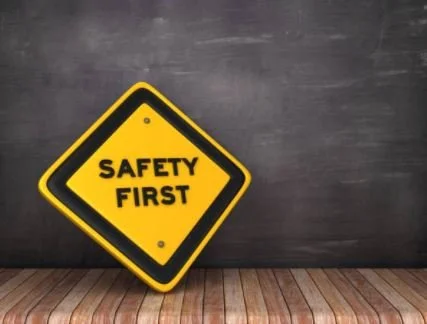WORK ZONE TRAFFIC CONTROL PART 6
To stop traffic
Stand in a safe position on the shoulder. Face traffic and extend the paddle in a vertical position
so the full STOP face can be seen by approaching drivers. Night flagging may include the use of
a red lantern or light. To stop traffic the light should be waved back and forth across the path of
an approaching vehicle
Read More
WORK ZONE TRAFFIC CONTROL PART 5
To you, the flagger:
You have been chosen as a traffic flagger because your supervisor feels you are physically able,
mentally alert, and sufficiently commanding in appearance to be obeyed by the motoring public.
You are an indispensable part of all maintenance and construction operations. We want you to
study the following instructions so that they become second nature. Your life, the lives of your
fellow workers, and the lives of highway users depend upon your alertness and on your ability to
control traffic with your stop-slow sign paddle.
Read More
WORK ZONE TRAFFIC CONTROL PART 4
LMK Pipe Renewal facilities on state highway right of ways are to be maintained in a manner
satisfactory to the State of Florida and at LMK Pipe Renewal expense.
Read More
WORK ZONE TRAFFIC CONTROL PART 3
Frequent and abrupt changes in geometries that require rapid maneuvers (such as lane narrowing,
dropped lanes, or main roadway transitions) should be avoided. Provisions should be made for
the safe operation of work vehicles, particularly on high-speed, high-volume roadways.
Read More
WORK ZONE TRAFFIC CONTROL PART 2
Any member of the crew who serves as a flagger should be equipped with a Stop-Slow paddle and a reflective vest. Crewmembers shall be trained for proper flagging procedures.
Read More
THE FIRE TRIANGLE
Let's talk about what makes a fire and what we can do to prevent one. Fire can be
compared to a triangle. Three sides are necessary to make a triangle and three
ingredients are necessary to cause a fire. These are heat, air, and fuel. If any one of
these three sides is missing, there can be no fire.
Read More
THE IMPORTANCE OF SLEEP
The importance of adequate sleep cannot be overstated. Sleep has many effects on a variety of aspects of our health. The way you feel awake has a link to what kind of sleep you get at night. Poor sleeping habits can lead to an acute sudden incident, such as a car crash due to a tired driver, or chronic problems over the long term such as a number of health issues.
Read More
VERIFYING SAFEGUARDS
No matter if you or someone else is responsible for implementing a safeguard, safeguards should be verified that they are in place prior to beginning work….
Read More
STRUCK BY INCIDENTS
With all of the moving equipment, flying debris, and falling objects on a construction site it can be a very dangerous place for an individual on the ground. It is important to understand the specific hazards of the work for that day as well as the job site overall as ground personnel who will be on the job site. Furthermore, everyone needs to work together to eliminate or mitigate the hazards that result in struck-by incidents.
Read More
Lock Out - Tag Out
If you are required to repair or maintain any machinery or equipment, or any electrical power source, start the job by locking out and tagging out all energy sources and starting mechanisms. Locking or tagging out is the only sure way to prevent other employees from accidentally activating the system.
Read More
WORK ZONE AND TRAFFIC CONTROL PART 1
All requirements pertaining to the safety, employees in the above listed publications are included in this Safety Manual by reference. In this Safety Manual, it is not practical to prescribe detailed requirements for all situations that may arise; therefore, it is the responsibility of individual employees to determine applicability of the aforementioned publications to their own activities.
Read More
ACCIDENTS OR FIRE HAZARDS
Fire Hazards
If a fire breaks out in a LMK facility and it cannot be immediately and completely extinguished, you should follow the Emergency Reporting Procedures listed below.
Read More
COLLECTION SAFETY SYSTEM PART 3 (PERSONAL SAFETY EQUIPMENT)
The following is a list of the safety equipment that should be worn and/or used by all employees working in sewer manholes at all times, unless stated otherwise.
Read More
COLLECTION SAFETY SYSTEM PART 2 ( GENERAL SAFETY PRECAUTIONS)
The following are the proper procedures and general safety precautions that will be followed
before entering a manhole for the purpose of taking flow measurements, performing inspections
or making sewer repairs:
Read More
Muddy Work Areas
Weather can create many hazards and slow down production for construction sites and other work sites that are outdoors. This is especially true when rain creates excessively muddy conditions.
Read More
DANGERS OF SPIDERS
Spiders are feared by many people all around the world. For the most part, they are harmless creatures to humans. However, there is a small number of species that are known to be a danger to humans. In the United States, there are two kinds of spiders that are normally mentioned as a danger to a person’s health if bitten. These spiders are of the recluse type and the widow type.
Read More
Scaffolding
It's a terrible thing to realize that hardly a workday goes by without a construction worker falling off a scaffold to his death. And those who survive scaffold falls are often crippled for the remainder of their lives.
These tragedies are sometimes caused by faulty design or poor construction. But in most cases, the basic cause is poor maintenance or improper use - something that you can do something about.
Read More
Costs of Drugs on the Job
Individuals who come to work under the influence of drugs and alcohol are a big concern for many employers across the world. In the United States, it is estimated over 60% of employers conduct pre-employment drug screen. The cost of these tests are anywhere from $20 to $60 a piece. Since employers are willing to spend this amount of money on screening employees many find that the benefits outweigh the costs.
Read More
GASOLINE SAFETY
Gasoline is common both on the job and at home for use in both vehicles and equipment we use every day. It is important to practice safe handling and storage of gasoline to avoid spills and fires. Improper use and storage of gasoline leads to many injuries as well as property damage year after year.
Read More




















